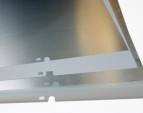
New Info on Water Ionizer Plates
Water Ionizer Plates: How Many Do You Need?
A water ionizer’s plates or “electrodes” are one of the two most important components when it comes to ionization potential. The plate technology used in water ionizers varies from company to company with the number of plates used varying based on the model.
This segment will give you a good understanding of the types of plates used in most water ionizers currently available on the market today. By understanding plate technology you’ll have a better shot at choosing a water ionizer that will produce good quality ionized water.
Plate Design Basics
All reputable water ionizer companies start with a high grade titanium to form the plates which are then cut to size and two layers of platinum are applied for better electrical conductivity.
Water ionizer plates fall into two basic categories – flat or mesh.
Flat plates are pretty straightforward. These are smooth, flat plates with no texture. Just a titanium plate with the platinum coating.
Mesh plates come in a variety of designs. These plates start with a solid piece of high-grade titanium which is then textured in a number of different ways. Once the plate has been “textured” it is double-coated with platinum.
Mesh Plate Designs
Mesh plates come in a variety of designs. Mesh plates can refer to electrodes that are slotted, true mesh or hybrid mesh.
A “true mesh” plate is an actual sheet of titanium mesh which looks much like a screen. Although the actual screen may be thick, this type of mesh plate can wear thin in some areas more quickly than other mesh designs.
Slotted mesh plates are solid plates with slots cut into them at intervals offer better electrode integrity than the mesh screen type of plates. The two layers of platinum coating are applied to the plate after the slots have been cut into titanium to ensure even coverage.
Hybrid mesh plates also start with a solid piece of titanium. Holes are then cut into them at intervals allowing for maximum texturing without sacrificing plate integrity. The two layers of platinum coating is applied after the holes have been cut to ensure effective coverage of all surfaces.
Of the mesh plate designs, hybrid mesh offers the most actual plate surface area.
The combination of actual plate surface area and texturing work together to increase the electrical conductivity of an electrode.
About Electrical Conductivity
Both titanium and platinum are highly conductive metals. Platinum is applied to the electrodes because it offers the highest level of electrical conductivity.
Mesh plates are the choice in hydrogen fuel cell technology. Hydrogen fuel cells use water electrolysis to produce hydrogen for fuel. Effective, efficient production requires optimal electrical conductivity. Mesh electrodes are used based on the laws of electrical conductivity which indicate that textured metal surfaces are better conductors of electricity than flat metal surfaces.
This is why most newer water ionizer technology now uses electrodes with some sort of mesh design – whether that is a mesh screen, slotted mesh or the newer hybrid mesh.
Summary
When looking at the components of the water ionizer you are considering for your home, take a look at the plate style and the number of plates. The more plates in a water ionizer, the more electrodes available to deliver the electrical charge to the water for ionization.
When it comes to plate design, plates with some sort of texturing will offer better electrical conductivity, enhancing the amount of electrical current delivered to the water for ionization.